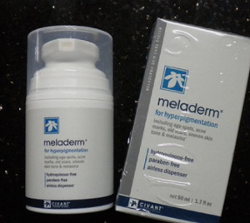 OK, first up, just what is a whitening cream? Sometimes they’re called brighteners or lighteners too, but they are basically the same thing.
OK, first up, just what is a whitening cream? Sometimes they’re called brighteners or lighteners too, but they are basically the same thing.
They are cosmetic products you use at home to either treat skin pigmentation — which could be anything from old acne scars to age spots, or just uneven skin tone areas — or even just to achieve an overall lighter skin.
Mostly they come as a cream, but sometimes a lotion or oil. Many can be used all over the body (but check the label first) including hands, arms, legs and of course on your face.
There are a lot of products available, and the quality does vary. They do however share many of the same ingredients, some of which you will probably want to avoid particularly if you favour more natural beauty products.
How Do They Work?
It’s all about melanin, which is the pigment that determines the color of your skin. Areas with excess melanin look darker. Areas with very high levels are what we call age spots or moles.
Some types of pigmentation will fade naturally over time, such as a sun tan or even acne scars. Others such as age spots will never fade. And acne scars can take a couple of years to fade – which is far too long for most of us!
So in simple terms skin whiteners reduce melanin.
But let me give you one quick warning. They don’t work overnight! You have to allow 2-4 weeks for them to gradually fade problem areas.
I know that’s not much fun if you’re impatient like me, but it’s a whole lot better than 2 years or never!
Good Ingredients To Look For
There are many natural (and naturally derived) ingredients used in these products. But here’s a quick list of some good ones to look out for:-
Arbutin
Also called Alpha Arbutin, this is an extract usually from the bearberry plant (a shrub which produces edible berries said to be a favorite food of bears!). This is a commonly used ingredient which has been shown to be effective at reducing melanin production [research link]
But also look for Alpha Arbutin, which has been shown to be even more effective – up to 10 times so. It’s very expensive to produce though so you won’t find it in the very cheap products.
Kojic Acid
This is widely used now instead of hydroquinone, but more on that in a moment. It actually comes from a fungus and is used in making sake (the Japanese rice wine). There’s also good research behind using this ingredient too.
Niacinamide
You might know this better as Vitamin B3. Which has been shown to be useful for all sorts of skin problems, including treating problem areas of dark skin [research link]
Vitamin C
Now I’m sure you’ve heard of this one :-). But there’s a good reason it’s commonly used, and there is lots of research to back it up too.
Others
There are lots of others often used too such as Gigawhite, Emblica Extract, Licorice Extract, Mulberry Extract, Glycolic Acid (an alpha hydroxy acid, or AHA), Vitamin K and even plain old extracts of lemon juice.
The research varies for these, but most have good scientific studies to back them up!
Ingredients To Avoid
Now there are some things you don’t really want in any lightening cream. And these are the main ones to watch out for:-
Hydroquinone
This used to be a very common ingredient. But it’s now been banned in some countries, and restricted to prescription only use in others. That’s probably all you need to know about that one!
Mercury
Again, this has now been banned in many countries for use in whitening creams as it can have some long term undesirable effects. So probably best avoided.
What’s My Favorite Product?
 Personally, I like the Meladerm cream. It includes all the key natural ingredients that you would want in a whitening product.
Personally, I like the Meladerm cream. It includes all the key natural ingredients that you would want in a whitening product.
Plus it has some other ingredients that are great for general skin treatment and conditioning (even those wrinkles!). And the price is good too – especially if you go for the larger bottle which works out even better value for money.
How Do You Apply Whiteners?
Step 1 – First you wet the area of your skin with warm water. Warm water opens the pores of the area of your skin that you wish to apply the whitening product to, allowing the nutrients and oils to permeate through and be absorbed by your skin.
Step 2 – Lightly exfoliate the area of your skin that you intend to apply the whitening cream to. You can do this by squirting a small amount of exfoliating cream into your palm and rubbing the scrub cream in a circular motion around the area. Exfoliating your skin will help you shed old and dead skin cells, giving you a smooth and clean surface to work with. If you intend to exfoliate an area on your face, please use an exfoliant cream that is meant for facial skin.
Step 3 – Now you rinse the exfoliant cream off your body with warm water and pat your skin dry with a clean towel. Try not to rub your skin dry as it may take away good skin cells along with the old and dead ones, so patting your skin dry does less damage to your skin surface.
Step 4 – Open your skin whitening cream and scoop or squirt the cream into the palm of your hand. Then rub the cream into the area that you have washed and exfoliated. Do this gently in circular motion until it has completely saturated into the area of your skin.
Step 5 – You can also apply the skin whitening cream again if you feel you need to, just allow your skin to rest for a few minutes in between applications to give you enough time to determine whether you need a second coat or not.
Read more about how to bleach your skin. And learn a bit more about some of the ingredients used in this video:-
Research Links
1. https://ntp.niehs.nih.gov/ntp/htdocs/chem_background/exsumpdf/arbutin_508.pdf
2. https://www.ncbi.nlm.nih.gov/pubmed/12100180
